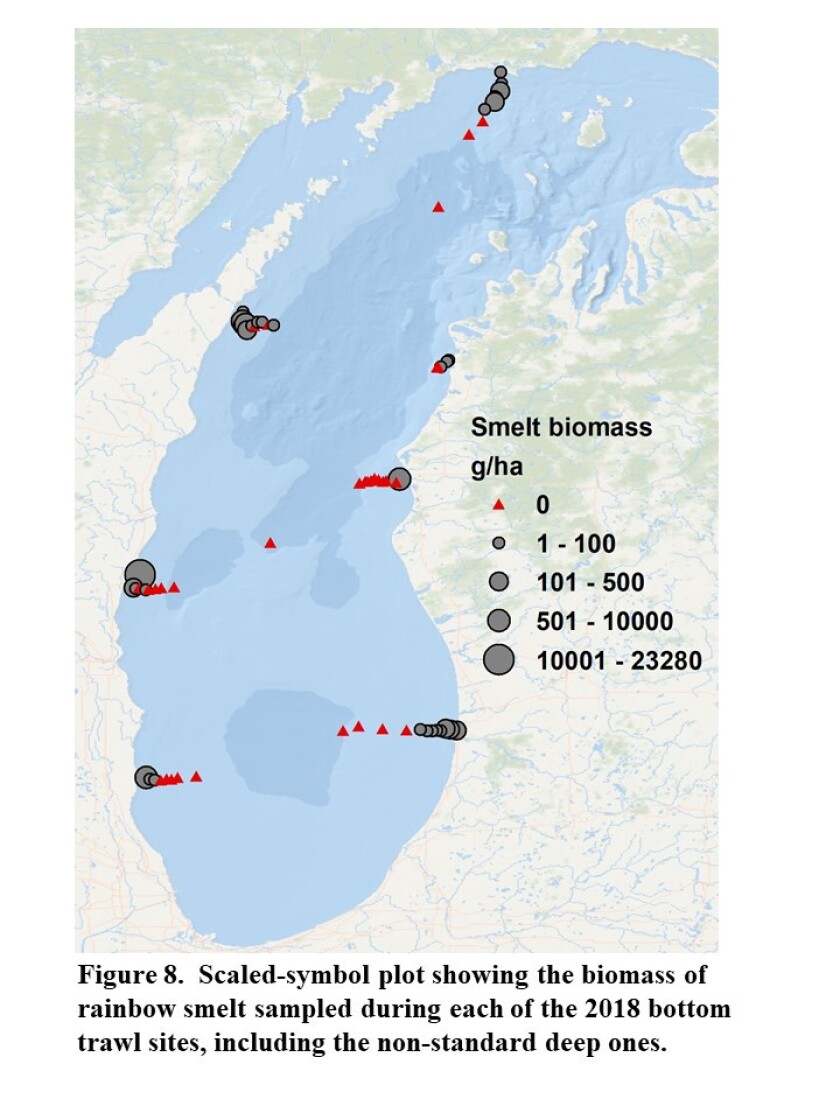Whooping and hollering came from those clustered around the smelt net pulled out of Lake Michigan Monday night on the wall between the Shedd Aquarium and the Adler Planetarium.
Call me a Doubting Thomas, but I couldn’t help but to reach to touch the smelt in the net to make sure “Jumbo Jimmy” Baczek hadn’t hoodwinked us by sticking frozen smelt from Jewel into the mesh. But the dozen smelt in the net were flopping and squishy, and most swam around when dropped into the orange bucket.
“You gotta have faith, Dale, you gotta have faith,” Baczek said.
If faith is belief in things unseen, it applies because in recent years we sure haven’t seen many or sometimes any smelt on the traditional April 1 opening night of smelt netting on the Chicago lakefront. Surveys have shown dismal prospects for rainbow smelt on Lake Michigan for years. In memory, past decades seem even more glorious.
At the men’s-only gathering of the Midwest Vans Ltd. club at Burnham Harbor/Northerly Island, Vince Rudar said of the old days, “We would net so many and wouldn’t even get to drink a beer. It was terrible.”
Yar.
To data. Waukegan is the one harbor in Illinois where the USGS sends out a bottom trawl for assessments annually. There are seven bottom trawls across Lake Michigan.
“Off of Waukegan, smelt catches were variable, but averaged about 6.3 kg/ha (or 5.6 lbs/acre) through 1997,” emailed, David “Bo” Bunnell, research fisheries biologist for the USGS at the Great Lakes Research Center in Ann Arbor, Mich. “And then something dramatically changed and catch rates haven’t exceeded 1 kg/ha since then. 2018 was a small uptick from previous year, but still below the average catch rate since 1999. Based on last year’s data, I wouldn’t expect any dramatic changes to the smelt fishery this year.
“It’s possible that catches might be slightly higher than last year given our survey results, but something in the ecosystem has changed such that smelt densities today are not as high as they used to be back in the 1980s through early 1990s.”
The modern reality is that smelting is more about enjoying food, drink and the night on the lakefront, than netting smelt to throw in hot oil.
As one of the Midwest Van Ltd. members said, “I don’t think there is a better look at the city.”
My favorite night view of Chicago is from Northerly Island. On another level, the van crew had wonderful sausages grilling and some one had brought real Labatt beer across from Canada.
Tom Palmisano, of Henry’s Sports and Bait in Bridgeport, and I have have trekked around the lakefront on most opening nights of smelt netting for the past decade-plus. This year, we started south–nothing at 43rd, 31st or McCormick–but found people around the Museum Campus/Burnham Harbor.
The group of friends and family with Baczek, who earned his nickname for his knack for catching jumbo perch from Steve Palmisano at Henry’s, used to be the norm. They had some specialty sausages grilling and recently-caught catfish nuggets in the deep fryer. Maybe the camaraderie, foot and drink is enough to keep the tradition going, because there are not indications of better prospects for smelt.
“I don’t anticipate a big change in smelt catches this spring compared to recent years because all indications are that smelt numbers are low in southern Lake Michigan,” emailed Vic Santucci, the IDNR’s Lake Michigan program manager. “We only caught one smelt in our prey fish netting assessments last spring. Bo can give you results from the USGS fall bottom trawl survey. I believe they did catch some smelt off Waukegan last fall, but compared to the 1970s and 80s numbers are still very low.”
Palmisano and I did not see anyone at Belmont and moved on to Montrose, which is usual the center of the smelting world. There were a few groups, but a skeleton of what once was.
“We got 130 three years ago,” Peter Kopf said on the edge of family and friends deep frying battered shrimp at the mouth of Montrose. “Before, we used to catch five-gallon buckets of them.”
But there is hope, at least for the tradition.
“I do not think there is much of a chance of smelt disappearing from Lake Michigan or the Great Lakes,” Bunnell answered. “They are one of the few preyfish species that occur in all five Great Lakes, which means they have the ability to be successful in a range of conditions (different lake productivities, temperatures, fish communities). They also mature at a relatively young age (1 or 2) which means they have the potential for relatively high reproduction success each year, even if it’s a relatively young population.”









